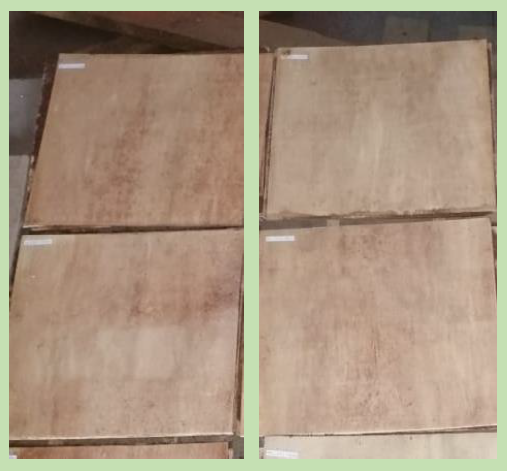Characteristic of plywood using wood mahagony bark powder as veneer bonding agent at several storage life

Downloads
Several barks from certain species, such as mahogany, have a relatively high tannin compound content. These tannin compounds have several hydroxyl groups that can be oxidized to produce radical groups. These radical groups can bind to wood chemical components through bonding mechanisms, such as esterification and phenoxy radicals coupling. The use of oxidized bark as a bonding agent has shown good characteristics of plywood. However, this method will have a problem, in terms of storage life, when being applied at industrial scale. The purpose of this study was to investigate the possible application of oxidized mahagony bark powder as a bonding agent for producing plywood and evaluate the relationship between storage life and the quality of bonding agent stock in the form of oxidized bark powder. The bark powder was oxidized using hydrogen peroxide and a catalyst. The oxidized powder was stored for 0 days, 1 day, 1 week (7 days), and 1 month (30 days) in a tightly closed container before being applied for the plywood manufacture. The tests carried out were physical and mechanical properties of plywood. The results showed that the physical properties of plywood using oxidized mahagony bark powder as a bonding agent with various storage periods have met SNI 5008.2:2016. However, the mechanical properties of the produced plywood were still below the standard. The results indicated that technology for producing plywood using oxidized bark powder is potential for further development
Bacigalupe, A., Molinari, F., Eisenberg, P., & Escobar, M. M. (2020). Adhesive properties of urea-formaldehyde resins blended with soy protein concentrate. Advanced Composites and Hybrid Materials, 3(2), 213–221.
Badan StandardisasiNasional. (2016). Kayu Lapis Penggunaan Umum, SNI 5008.2:2016. Jakarta: BSN.
Cahyono, T. D., Darmawan, W., & Novriyanti, E. (2020). Performance of samama (Anthocephalus macrophyllus) LVL based on veneer thickness, juvenile proportion and lay-up. Wood Material Science and Engineering, 15(3), 155–162.
Cahyono, T. D., Wahyudi, I., Priadi, T., & Febrianto, F. (2017). Kualitas kayu lapis dari finir bagian juvenil dan dewasa samama. JurnalIlmu dan Teknologi Kayu Tropis, 15(2), 155–166.
Daoui, A., Descamps, C., Marchal, R., & Zerizer, A. (2011). Influence of veneer quality on beech LVL mechanical properties. Maderas: Ciencia y Tecnologia, 13(1), 69–83.
Fatriasari, W., & Ruhendi, S. (2010). Fortifikasi perekat lateks karet alam-stirena dengan isosianat: karakteristik dan aplikasinya pada kayu lapis. JurnalIlmu dan Teknologi Kayu Tropis, 8(2), 121–132.
Fauziyah, W. H. (2011). Karakteristik Kayu Lapis dari Jenis Kayu Berdiameter Kecil (Small Diameter Log). (Skripsi). Bogor: IPB University.
Gonçalves, D., Bordado, J. M., Marques, A. C., & Dos Santos, R. G. (2021). Non-formaldehyde, bio-based adhesives for use in wood-based panel manufacturing industry—a review. Polymers, 13(23).
Hajriani, S., Yunianti, A. D., Suhasman, S., & Lestari, A. S. R. D. (2021). Karakteristik ekstrak tanin kulit kayu pinus (Pinus merkusiiJungh et de Vriese). Jurnal Penelitian Kehutanan Wallacea, 10(1), 93–102.
Junaedi, D. E. (2018). Pemanfaatan serbuk kulit bakau dan akasia sebagai pengganti perekat sintetis dalam pembuatan plywood. (Skripsi) Makassar: Universitas Hasanuddin.
Kabe, A., Darmawan, W., & Massijaya, M. Y. (2012). Karakteristik finir kupas kayu sengon (Paraserianthes falcataria). JurnalIlmu dan Teknologi Kayu Tropis, 10(2), 139–149.
Łebkowska, M., Załęska-Radziwiłł, M., & Tabernacka, A.(2017). Adhesives based on formaldehyde –environmental problems. Biotechnologia, 98(1), 53–65.
Okai, R., Frimpong-Mensah, K., &Yeboah, D. (2003). Characterization of moisture content and specific gravity of branchwood and stemwood of Aningeria robusta and Terminalia ivorensis. Holz als Roh -und Werkstoff, 61(2), 155–158.
Ozsahin, S., & Murat, M. (2018). Prediction of equilibrium moisture content and specific gravity of heat treated wood by artificial neural networks. European Journal of Wood and Wood Products, 76(2), 563–572.
Rahayu, I., Darmawan, W., Nugroho, N., & Marchal, R. (2015). The effect of jabon veneer quality on laminated veneer lumber glue bond and bending strength. JurnalIlmu dan Teknologi Kayu Tropis, 13(2),98–110.
Rakhmawan, S., Suryono, A., Nofrida, F., & Suheri. (2021). Statistik Perdagangan Luar Negeri Indonesia, Ekspor 2020, Jilid I(M. Hertinmalyana & H. Sulaiman (ed.)). Badan Pusat Statistik.
Salthammer, T., Mentese, S., & Marutzky, R. (2010). Formaldehyde in the indoor environment. Chemical Reviews, 110(4), 2536–2572.
Shmulsky, R., & Jones, P. D. (2019). Forest Products and Wood Science: An Introduction. In R. Shmulsky & P. D. Jones (Ed.), John Wiley & Sons, Inc.(7th Ed.). Hoboken, New Jersey, USA: John Wiley & Sons, Inc.
Suhasman, S., & Agussalim. (2019). Resinless plywood production by using oxidized acacia bark powder as a binder.IOP Conference Series: Materials Science and Engineering, 593, 012010.
Widsten, P. (2002). Oxidative Activation of Wood Fibers for the Manufacture of Medium-Density Fiberboard (MDF). In Laboratory of Paper Technology. Helsinki, Finlandia: Helsinki University of Technology.




